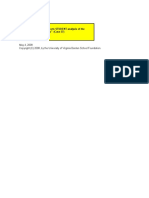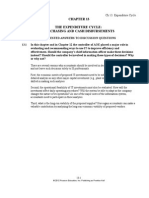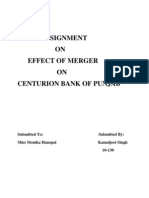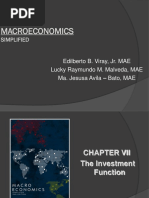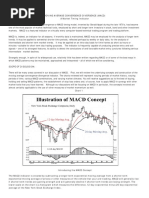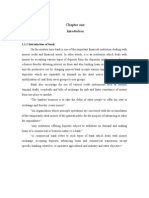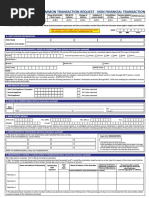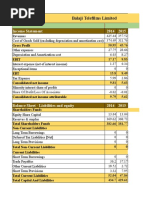Las Ferreterfas de Mexico
Las Ferreterfas de Mexico
Uploaded by
dwirusmintCopyright:
Available Formats
Las Ferreterfas de Mexico
Las Ferreterfas de Mexico
Uploaded by
dwirusmintCopyright
Available Formats
Share this document
Did you find this document useful?
Is this content inappropriate?
Copyright:
Available Formats
Las Ferreterfas de Mexico
Las Ferreterfas de Mexico
Uploaded by
dwirusmintCopyright:
Available Formats
Las Ferreterias de Mexico, S.A. de C.V.
We had been operating our company like a family, but maybe were too big to operate that way. I think some of our people have gotten lazy, and our performance has suffered. That is why I asked for the design of a new incentive compensation plan. We need to be more competitive to survive. I want our people to focus on what they can do to improve company performance, and if were successful, I am quite willing to share a good proportion of the procceds of our success. -Fernando Gonzalez Chairman and CEO Las Ferreterias de Mexico, S.A. de C.V.
THE COMPANY
Las Ferreterias de Mexico, S.A. de C.V. (Ferreterias) was the second largest retailer of lumber, building material, and home improvement products and materials and homeimprovemen product ans equipment in Mexico. Ferreterias operated 82 stores in Mexixo City and troughout most of the nortern regions of Mexico. Each of Ferreterias stores offered between 10,000 to 20,000 stock keeping units (SKUs) in a retail sales area, an outside lumberyard area, and in a garden center. The total store areas ranged from 10,000 to 35,000 square feet. Ferreterias was founded in 1902 in a suburb of Mexico City by Fernando Gonzalezs grandfather. Over the years, the company added more locations. It was listed on the Mexican Stock Exchange in 1983. In 2002. EXIBIT 1 LAS FFETERIAS DE MEXICO, S.A. D.V. Income Statement as of 12/31/2002 (Ps 000) Net sales 2,216,540 Costs of sales 1,582,670 Gross Margin 633,870 Selling, General and Administrative Expenses 377,580 Depreciation Expense 65,740 Interest Expenses 14,320 Total Expenses 457,640 Earnings before Taxes 176,230 Incesome Tax Provision 58, 240 Net Earning after Taxes 117,990 Ferreterias had saies of 2.210 million pesos and profits of almost 120 million pesos (see summary financial statements in Exhibits 1 and 2).
Starting in the late 1980s, Fernando Gonzalez launched a major company needed to emulate the methods of the large American homebuilding retailers, such as Home Depot and Lowes, in order to survive. Thus, improving market share and improving operation efficiencies becme Ferreterias` strategic priorities. The store managers enjoyed considerable autonomy. They were responsible for hiring, firing, and supervising their store`s personnel. While the store hnd the same architectural designs and some basic stock keeping requirements, the individual store managers were allowed to adapt their merchandise offerings, their inventory levels, and their advertising and promotional activities to their local markets, which were quite diverse. The store managers were given considcrable latitude to reduce princes to move excess inventory or to meet competition. They were responsible for making creditgranting decisions, although for large accounts they were expected to ask finance personnel at headquarters to perform a credit check. And some aggressive store managers tried to generate new business by calling on prospective customers themselves. The 82 store were organized into nine geographical regions. The regional managers, each of whom was a former store manager, provided oversight and advice. At the of the case, one Mexican peso worth approximately USS0.10. Their role was seen as an important part of the management structure because most of the store managers had little formal education. Only a few were college educated, and few of those had formal business education. Each region also contained a regional sales office with specialisis who worked with larger customers, though, were made through the store nearest to the job. The corporate staff of Ferreterias provided a range of centralized function, including purchasing, human resources, marketing, real estate, and investor relations. Inventory was shipped to the store from one of three regional warehouses. All Ferreterias employees were paid a base salary or hourly wage plus a bonus based on a share of the companys overall profits. These bonuses were small, usually in the range of 2 5 percent of base salary, depending on organization level. In addition, Fernando Gonzalez typically provided some discretionary bonus awards to employees whose performance in a given year was exemplary. Generally, though, these types of bonuses were not considered to be effective at motivating behavior, as was indicated in the comment by Mr. Gonzalez presented at the beginning of the case. A NEW INCENTIVE PLAN In July 2002, Mr. Gonzalez hired a consulting firm to design a new performance-based compensation plan. He asked his chief financial officer and head of human resources to assist the firm with its work. Mr. Gonzalez`s original intent was to include all company salesmen, buyers, and managers in the new incentive plan. After a series of interviews, however, the consulting firm reported that it would not be easy to measure the performances of either salesmen of buyers. While most customers were assigned to one particular salesperson, it was difficult to assess whether a sale came from the assignes salesperson`s offorts. Many customers had dealt with Ferreterias for years, and they placed their orders regardless of whether or not they received a call from a Ferreterias salesperson. Some of the large contractors had also established personal relationships with one or more corporate or regional staff, and oftentimes they called their friends for advice, rather than relying on the salesperson
formally assigned to them. Measuring the performances of the buyers was similarly problematic. The primary aspect of buyer performance that could be measured the prices paid for items purchased-was affected by many factors over which the buyer had little control. These included the order size and market conditions. Because of these measurement problems, the consultants concluded that the measures that could be tracked would not provide meaningful bases on which to assign bonus awards. They recommended that they work first on designing an incentive plan for managers, which included the individual store managers (82), regional managers (9). And corporate staff managers (5). (Neither Fernando Gonzalez nor his chief operating officer was to be included in this plan: the compensation committee of the company`s board of directors determmed their bonuses). The consultant`s suggestion for the management incentive plan included the following features: 1. Bonus pool. A total bonus pool would be created according to the following formula: 4 million pesos plus 8 percent of the corporate income before bonuses and taxes in excess of 120 million pesos. The total bonus pool would be divided into three classes as follows: Store managers 70% Regional managers 15% Corporate staff managers 15% 2. ROI measure of performance. The bonus pools would be assigned to managers based on their entity`s return on investment (ROI). Defined as bonuseligible revenues minus expenses divided by total store investments. The following gundelines were provided to facilitate the calculation of the ROI for bonus purposes. The revenues eligible for bonuses include all shipments from the store except those stemming from sales orders written by regional or headquarters personnel. The expenses include all direct store costs and all regional and headquarters costs. The costs of significant regional and headquarters activities traccable directly to a given store . Cost of preparing a customer credit report, cost of a building upgrade would be charged directly to that store. All other costs would be allocated to the stores. Activity-based allocations would be used where possible, such as in using the stores relative proportions of receipts into inventory to allocate purchasing expenses. All other expenses would be allocated based on a proportion of bonus-eligible store revenues. 3. Allocation .. For store managers who had been in that position for less than the full year and managers who transferred between stores during a year, bonus units would be assigned by the relevant regional manager(s) by applying the basic bonus unit award philosophy as closely as possible. The regional managers` bonus pool would be divided among the regional managers based on a proportion of the bonus units earned by the stores in their region divided by the total bonus units earned by all stores.
The allocation of the corporate staff bonus pool would be decided by Fernando Gonzalez based on the corporation`s annual ROI performance. 4. Form of the awards. Bonuses were to be paid in cash as soon as the financial statements were prepared and audited and the amounts could be calculated. CONCERNS BEFORE IMPLEMENTATION As Mr. Gonzalez looked over the consulting firm`s design, he had some concerns. First, it was obvious to him that the new plan would increase the company`s compensation expense. How much would that expense increase, and would the benefits of the plan be worth that expenditure? Second, he knew that he would have to be the one to announce the implementation of the plan. He had to anticipate what his managers` reactions would be. What were they mostly likely to complain about? Is this plan fair to all of the managers? And, finally, he still lamented the fact that personnel in the regional sales and corporate purchasing organizations were not included in this plan. If their individual performances could not be measured objectively, was there some other way he could motivate them and reward them for performing their roles, which were critical to the company`s success? Questions 1. Evaluate the proposed performance measurement and incentive plan 2. How, if at all, would you modify the proposed plan?
Ferreterias las de Mexico, S.A. de C.V. Kami telah beroperasi perusahaan kami seperti sebuah keluarga, tapi mungkin kita terlalu besar untuk beroperasi seperti itu. Saya pikir beberapa orang kami mendapatkan malas, dan kinerja kami telah menderita. Itu sebabnya saya diminta untuk desain rencana kompensasi insentif baru. Kami perlu lebih kompetitif untuk bertahan hidup. Saya ingin orang-orang kami untuk fokus pada apa yang dapat mereka lakukan untuk meningkatkan kinerja perusahaan, dan jika kita berhasil, saya sangat bersedia untuk berbagi proporsi yang baik dari Pencairan kesuksesan kami. -Fernando Ketua Ferreterias Gonzalez las dan de CEO Mexico, S.A. de C.V.
PERUSAHAAN Ferreterias las de Mexico, S.A. de C.V. (Ferreterias) adalah peritel terbesar kedua kayu, bahan bangunan, dan produk perbaikan rumah dan bahan-bahan dan peralatan homeimprovemen produk oz di Meksiko. Ferreterias dioperasikan 82 toko di Mexixo Kota dan Sepanjang sebagian besar daerah nortern Meksiko. Setiap toko Ferreterias ditawarkan antara 10.000 hingga 20.000 menjaga stok unit (SKU) di daerah penjualan ritel, daerah tempat penjualan kayu di luar, dan di pusat taman. Area total toko berkisar antara 10.000 hingga 35.000 kaki persegi. Ferreterias didirikan pada tahun 1902 di pinggiran kota Mexico City oleh kakek Fernando Gonzalez. Selama bertahun-tahun, perusahaan menambahkan lebih banyak lokasi. Itu tercatat di Bursa Efek Meksiko pada tahun 1983. Pada tahun 2002. 1 FFETERIAS LAS Laporan Laba Rugi Penjualan Biaya Gross Penjualan, Biaya Beban Beban Jumlah Laba Pajak Laba DE EXIBIT MEXICO, per 2002/12/31 S.A. (Mzm D.V. 000)
bersih penjualan Margin Umum
dan 377.580
2.216.540 1.582.670 633.870 Administrasi
Penyusutan 65.740 Bunga 14320 Beban 457.640 sebelum Pajak 176230 Incesome Penyisihan 58, 240 bersih setelah pajak 117.990
Ferreterias telah saies dari 2,210 juta peso dan keuntungan hampir 120 juta peso (lihat ringkasan laporan keuangan dalam Bukti 1 dan 2). Dimulai pada akhir 1980-an, Fernando Gonzalez meluncurkan sebuah perusahaan besar
yang diperlukan untuk meniru metode pengecer homebuilding besar Amerika, seperti Home Depot dan Lowe's untuk bertahan hidup. Dengan demikian, meningkatkan pangsa pasar dan meningkatkan efisiensi operasi becme Ferreterias `prioritas strategis. Para manajer toko menikmati otonomi yang cukup. Mereka bertanggung jawab untuk merekrut, menembak, dan mengawasi toko mereka `personil. Sementara toko HND desain arsitektur yang sama dan beberapa saham dasar menjaga persyaratan, para manajer toko individu diizinkan untuk menyesuaikan penawaran barang dagangan mereka, tingkat persediaan mereka, dan iklan dan kegiatan promosi untuk pasar lokal mereka, yang cukup beragam. Para manajer toko diberikan lintang considcrable untuk mengurangi pangeran untuk memindahkan kelebihan persediaan atau bertemu dengan persaingan. Mereka bertanggung jawab untuk membuat keputusan pemberian kredit, meskipun untuk account besar mereka diharapkan untuk meminta petugas keuangan di kantor pusat untuk melakukan pemeriksaan kredit. Dan beberapa manajer toko agresif mencoba untuk menghasilkan bisnis baru dengan menyebut calon pelanggan sendiri. Toko 82 diorganisir menjadi sembilan wilayah geografis. Para manajer regional, masingmasing adalah mantan manajer toko, memberikan pengawasan dan nasihat. Pada kasus ini, USS0.10 satu bernilai sekitar peso Meksiko. Peran mereka terlihat sebagai bagian penting dari struktur manajemen karena sebagian besar manajer toko telah pendidikan formal sedikit. Hanya sedikit yang berpendidikan perguruan tinggi, dan hanya sedikit dari mereka memiliki pendidikan bisnis formal. Setiap daerah juga berisi sebuah kantor penjualan regional dengan specialisis yang bekerja dengan pelanggan yang lebih besar, meskipun, itu dilakukan melalui toko terdekat dengan pekerjaan. Staf perusahaan dari Ferreterias memberikan berbagai fungsi terpusat, termasuk pembelian, sumber daya manusia, pemasaran, real estate, dan hubungan investor. Persediaan telah dikirim ke toko dari salah satu dari tiga gudang regional. Semua karyawan Ferreterias dibayarkan gaji pokok atau upah per jam plus bonus berdasarkan bagian dari keuntungan perusahaan secara keseluruhan. Ini bonus masih kecil, biasanya dalam kisaran 2 - 5 persen dari gaji pokok, tergantung pada tingkat organisasi. Selain itu, Fernando Gonzalez biasanya disediakan beberapa penghargaan discretionary bonus kepada karyawan yang kinerjanya pada tahun tertentu yang patut dicontoh. Secara umum, meskipun, jenis bonus tidak dianggap efektif memotivasi perilaku, seperti yang ditunjukkan dalam komentar oleh Mr Gonzalez disajikan pada awal kasus. Sebuah RENCANA INSENTIF BARU Pada bulan Juli 2002, Mr Gonzalez menyewa perusahaan konsultan untuk merancang rencana kompensasi yang baru berbasis kinerja. Dia meminta direktur keuangan dan kepala sumber daya manusia untuk membantu perusahaan dengan pekerjaannya. Mr Gonzalez `s Niat awalnya adalah untuk memasukkan salesman semua perusahaan, pembeli, dan manajer dalam rencana insentif baru. Setelah serangkaian wawancara, bagaimanapun, perusahaan konsultan melaporkan bahwa itu tidak akan mudah untuk mengukur kinerja baik salesman pembeli. Sementara kebanyakan pelanggan ditugaskan ke salah satu penjual tertentu, sulit untuk menilai apakah penjualan berasal dari penjual assignes `s offorts. Banyak pelanggan telah menangani Ferreterias selama bertahuntahun, dan mereka menempatkan pesanan mereka terlepas dari apakah atau tidak mereka
menerima telepon dari seorang penjual Ferreterias. Beberapa kontraktor besar juga menjalin hubungan pribadi dengan satu atau lebih staf perusahaan atau regional, dan seringkali mereka menyebut teman-teman mereka untuk saran, daripada mengandalkan tenaga penjual secara resmi ditugaskan kepada mereka. Mengukur kinerja pembeli adalah sama bermasalah. Aspek utama dari kinerja pembeli yang bisa mengukur harga yang dibayar untuk barang yang dibeli-dipengaruhi oleh banyak faktor dimana pembeli memiliki kontrol sedikit. Ini termasuk ukuran pesanan dan kondisi pasar. Karena masalah-masalah pengukuran, konsultan menyimpulkan bahwa tindakan yang dapat dilacak tidak akan memberikan dasar yang bermakna untuk memberikan penghargaan bonus. Mereka merekomendasikan bahwa mereka bekerja pertama pada merancang rencana insentif bagi manajer, yang mencakup manajer toko individu (82), manajer regional (9). Dan manajer staf perusahaan (5). (Baik Fernando Gonzalez atau chief operating officer-nya untuk dimasukkan dalam rencana ini: komite kompensasi perusahaan `s direksi determmed bonus mereka). Konsultan `s saran untuk rencana insentif manajemen mencakup beberapa fitur berikut: 1. Bonus renang. Sebuah kolam total bonus akan diciptakan menurut rumus berikut: 4 juta peso plus 8 persen dari laba perusahaan sebelum bonus dan pajak lebih dari 120 juta peso. Kolam total bonus akan dibagi menjadi tiga kelas sebagai berikut: Store manajer 70% Daerah manajer 15% Perusahaan staf manajer 15% 2. ROI mengukur kinerja. Kolam bonus akan ditugaskan untuk manajer berdasarkan pada entitas mereka `s laba atas investasi (ROI). Ditetapkan sebagai pendapatan bonuseligible dikurangi biaya dibagi dengan total investasi toko. Para gundelines berikut ini disediakan untuk memfasilitasi perhitungan ROI untuk keperluan bonus. Pendapatan memenuhi syarat untuk bonus mencakup semua pengiriman dari toko kecuali yang berasal dari pesanan penjualan ditulis oleh personel kepala perempat regional atau. Biaya termasuk semua biaya toko langsung dan semua biaya regional dan pusat. Biaya kegiatan regional dan pusat signifikan traccable langsung ke toko yang diberikan ... .... Biaya menyiapkan laporan kredit pelanggan, biaya upgrade bangunan akan dibebankan langsung ke toko itu. Semua biaya lainnya akan dialokasikan ke toko. alokasi berdasarkan aktivitas akan digunakan bila memungkinkan, seperti dalam menggunakan toko proporsi relatif dari penerimaan ke dalam persediaan untuk mengalokasikan biaya pembelian. Semua biaya lainnya akan dialokasikan berdasarkan proporsi pendapatan bonus-toko yang memenuhi syarat. 3. Alokasi ... ... ... ... .. Bagi manajer toko yang telah berada di posisi yang kurang dari satu tahun penuh dan manajer yang ditransfer di antara toko selama setahun, unit bonus akan diberikan oleh manajer regional yang relevan (s) dengan menggunakan unit bonus penghargaan filosofi dasar sedekat mungkin . Para manajer regional `kolam bonus akan dibagi di antara para manajer regional berdasarkan proporsi dari bonus yang diperoleh unit toko di wilayah mereka dibagi dengan unit total bonus yang diterima oleh semua toko. Alokasi bonus kolam staf perusahaan akan diputuskan oleh Fernando Gonzalez berdasarkan korporasi `s kinerja tahunan ROI.
4. Bentuk penghargaan. Bonus itu harus dibayar secara tunai segera setelah laporan keuangan disusun dan diaudit dan jumlah yang dapat dihitung. MASALAH SEBELUM PELAKSANAAN Seperti Mr Gonzalez memandang perusahaan konsultan desain `s, ia memiliki beberapa kekhawatiran. Pertama, jelas baginya bahwa rencana baru akan meningkatkan perusahaan `s beban kompensasi. Berapa yang meningkatkan biaya, dan akan manfaat rencana bernilai bahwa pengeluaran? Kedua, ia tahu bahwa ia harus menjadi orang yang mengumumkan pelaksanaan rencana tersebut. Dia harus mengantisipasi apa yang manajernya `akan reaksi. Apa yang mereka kebanyakan cenderung mengeluh tentang? Apakah rencana ini adil bagi semua manajer? Dan, akhirnya, ia masih menyesali kenyataan bahwa personel dalam penjualan regional dan organisasi pembelian perusahaan tidak dimasukkan dalam rencana ini. Jika kinerja individu mereka tidak dapat diukur secara obyektif, apakah ada cara lain dia bisa memotivasi mereka dan penghargaan mereka untuk melakukan peran mereka, yang penting untuk perusahaan `s sukses? Pertanyaan 1. Evaluasi pengukuran kinerja yang diusulkan dan rencana insentif 2. Bagaimana, jika sama sekali, akan Anda mengubah rencana yang diusulkan?
You might also like
- Sfac No.2 Fasb PDFDocument38 pagesSfac No.2 Fasb PDFayuputrityaNo ratings yet
- Case 37 Baker Adhesives SolutionDocument22 pagesCase 37 Baker Adhesives SolutionLeopold StaffNo ratings yet
- Tips For The Emerson Electric CaseDocument3 pagesTips For The Emerson Electric CaseCahyo Priyatno0% (1)
- Case 4 5 Dana Packaging and Ada PharmaDocument2 pagesCase 4 5 Dana Packaging and Ada PharmaSoorajKrishnanNo ratings yet
- Chapter 6 (Day 2) SolutionsDocument3 pagesChapter 6 (Day 2) SolutionsFredie LeeNo ratings yet
- Latihan Soal Sesi 3 - Nastiti Kartika DewiDocument26 pagesLatihan Soal Sesi 3 - Nastiti Kartika DewiNastiti KartikaNo ratings yet
- Chapter 9Document30 pagesChapter 9desy adawiyahNo ratings yet
- ch09 Accounting Systems Solution ManualDocument10 pagesch09 Accounting Systems Solution ManualLindsey Clair RoyalNo ratings yet
- RMFI Software v1.00Document39 pagesRMFI Software v1.00RENJiiiNo ratings yet
- LME Aluminium Factsheet PDFDocument6 pagesLME Aluminium Factsheet PDFIshan Agarwal50% (2)
- BEIFANGDocument10 pagesBEIFANGUmar AzizNo ratings yet
- Tugas Kasus 1 - Sistem Informasi & PengendalianDocument9 pagesTugas Kasus 1 - Sistem Informasi & PengendalianHapsara SuryaNo ratings yet
- Case Chapter 12Document3 pagesCase Chapter 12rika kartikaNo ratings yet
- Financial Accounting Disclosure Makalah ImamDocument16 pagesFinancial Accounting Disclosure Makalah ImamImam AhmadNo ratings yet
- Rais12 SM ch13Document32 pagesRais12 SM ch13Edwin MayNo ratings yet
- Question and Answer - 60Document31 pagesQuestion and Answer - 60acc-expertNo ratings yet
- Tugas 3 - AMLDocument3 pagesTugas 3 - AMLcatharina arnitaNo ratings yet
- Case 7-4 Aloha Products (Summary)Document2 pagesCase 7-4 Aloha Products (Summary)Aanal PatelNo ratings yet
- Beifang Chuang Ye Vehicle Group Case Study Accounting 6120Document4 pagesBeifang Chuang Ye Vehicle Group Case Study Accounting 6120queeny 33No ratings yet
- Ada Pharmaceutical Company Produces Three Drugs Diomycin HomycDocument2 pagesAda Pharmaceutical Company Produces Three Drugs Diomycin HomycAmit PandeyNo ratings yet
- F00540010220143001Homework Chapter 19 and 21Document2 pagesF00540010220143001Homework Chapter 19 and 21Nur Hidayah K FNo ratings yet
- Managerial Accounting - 2Document2 pagesManagerial Accounting - 2Layla AfidatiNo ratings yet
- Mayora Indah TBK PDFDocument84 pagesMayora Indah TBK PDFsherlijulianiNo ratings yet
- Functional Based Responsibility AccountingDocument5 pagesFunctional Based Responsibility AccountingOgeb SahajaNo ratings yet
- NYTDigitalDocument21 pagesNYTDigitalRuchi SainiNo ratings yet
- Lecture 4 EMADocument36 pagesLecture 4 EMAYai IbrahimNo ratings yet
- E Business 1 6Document31 pagesE Business 1 6Fikra HanifNo ratings yet
- Topic Requirements: Below Are My Answers To The Two Requirements For The Topic On Profit Planning. 1. Ethics ChallengeDocument10 pagesTopic Requirements: Below Are My Answers To The Two Requirements For The Topic On Profit Planning. 1. Ethics ChallengeDudz BaywongNo ratings yet
- Penerapan PSAK 73 - MaterialDocument77 pagesPenerapan PSAK 73 - Materialni made safitriNo ratings yet
- Case - Ohio Rubber Works Inc PDFDocument3 pagesCase - Ohio Rubber Works Inc PDFRaviSinghNo ratings yet
- Alvin A. Arens Auditing and Assurance Services Ed 16 (2017) - MHS-halaman-530-550-halaman-9 PDFDocument1 pageAlvin A. Arens Auditing and Assurance Services Ed 16 (2017) - MHS-halaman-530-550-halaman-9 PDFNeni Henday100% (1)
- Management Accounting Atkinson, Et - Al Chapter 9 Behavioral and Organizational Issues in Management Accounting and Control SystemsDocument13 pagesManagement Accounting Atkinson, Et - Al Chapter 9 Behavioral and Organizational Issues in Management Accounting and Control Systemsdenaaraa100% (1)
- CH 15 Anchoring On The Financial Statements Simple Forecasting and Simple ValuationDocument25 pagesCH 15 Anchoring On The Financial Statements Simple Forecasting and Simple ValuationRocky HunilaNo ratings yet
- Sipi 15Document41 pagesSipi 15Antonius MulyonoNo ratings yet
- Audit Sampling For Tests of Details of BalancesDocument4 pagesAudit Sampling For Tests of Details of Balancesmrs leeNo ratings yet
- Acg5205 Solutions Ch.16 - Christensen 12eDocument10 pagesAcg5205 Solutions Ch.16 - Christensen 12eRyan NguyenNo ratings yet
- Tugas Sesi 3 - AML PDFDocument2 pagesTugas Sesi 3 - AML PDFcatharina arnitaNo ratings yet
- 8 TA Normative - The Case of Conceptual Framework ProjectsDocument57 pages8 TA Normative - The Case of Conceptual Framework ProjectsArum SariNo ratings yet
- Variance Analysis Problem MCSDocument2 pagesVariance Analysis Problem MCSKunjan ChaudharyNo ratings yet
- The Wallace GroupDocument22 pagesThe Wallace GroupRoselyn PamaNo ratings yet
- Not - For - Profit OrganizationsDocument51 pagesNot - For - Profit OrganizationsGlenn TaduranNo ratings yet
- Worthington Industries Case 12-3Document6 pagesWorthington Industries Case 12-3jim_mcdiarmid1100% (1)
- Case Study: Colombo Frozen YogurtDocument3 pagesCase Study: Colombo Frozen YogurtandresuminhNo ratings yet
- HomeWork MCS-Nurul Sari (1101002048) - Case 5.1 5.4Document5 pagesHomeWork MCS-Nurul Sari (1101002048) - Case 5.1 5.4Nurul SariNo ratings yet
- Jawaban GSLC 1Document2 pagesJawaban GSLC 1Soniea DianiNo ratings yet
- AF201 ExamDocument14 pagesAF201 ExamShikhaNo ratings yet
- Jawaban Soal Pat JamesDocument6 pagesJawaban Soal Pat JamesfarisNo ratings yet
- Case Study of Arlington IndustriesDocument13 pagesCase Study of Arlington IndustriesRanielleNo ratings yet
- IT-Audit Team2Document1 pageIT-Audit Team2Von Andrei MedinaNo ratings yet
- CH 10Document2 pagesCH 10wakmenNo ratings yet
- Chapter 13: Risk, Cost of Capital, and Capital Budgeting: Corporate Finance Ross, Westerfield, and JaffeDocument15 pagesChapter 13: Risk, Cost of Capital, and Capital Budgeting: Corporate Finance Ross, Westerfield, and JaffePháp NguyễnNo ratings yet
- Solartronics IncDocument5 pagesSolartronics Incraman2303100% (2)
- De AngeloDocument17 pagesDe AngeloAnnisaAyuLestariNo ratings yet
- Tugas Week 10Document6 pagesTugas Week 10Carissa WindyNo ratings yet
- Cisco Case Study AnalysisDocument2 pagesCisco Case Study AnalysisVega AgnityaNo ratings yet
- Chapter 6 (Installment Sales)Document3 pagesChapter 6 (Installment Sales)Jean100% (1)
- Isa 300Document5 pagesIsa 300sabeen ansariNo ratings yet
- B1B121009 Linda Solusi Bab 8Document7 pagesB1B121009 Linda Solusi Bab 8Aslinda MutmainahNo ratings yet
- Case Shoppers MartDocument81 pagesCase Shoppers Martarya100% (1)
- Tugas PT3 Audit - Nanda Rizki Nugraha - 41801042Document6 pagesTugas PT3 Audit - Nanda Rizki Nugraha - 41801042Nanda RNNo ratings yet
- Individual Assignment s1, 2021Document4 pagesIndividual Assignment s1, 2021Ishani Singh100% (1)
- Cost Of Capital A Complete Guide - 2020 EditionFrom EverandCost Of Capital A Complete Guide - 2020 EditionRating: 4 out of 5 stars4/5 (1)
- Valuation of Swap ContractsDocument5 pagesValuation of Swap ContractsveronicaNo ratings yet
- Assignment On Activities of Dhaka Stock ExchangeDocument14 pagesAssignment On Activities of Dhaka Stock ExchangeMd Salim Uddin100% (1)
- Centurion Bank of PunjabDocument7 pagesCenturion Bank of Punjabbaggamraasi1234No ratings yet
- Nippon India Multicap FundDocument2 pagesNippon India Multicap FundScribbydooNo ratings yet
- Chapter 7Document20 pagesChapter 7norleen.sarmientoNo ratings yet
- Financial Analysis Automobile IndustryDocument38 pagesFinancial Analysis Automobile Industryali iqbalNo ratings yet
- Nutter Food and Beverage Term Sheets MaterialsDocument39 pagesNutter Food and Beverage Term Sheets MaterialsSheila EnglishNo ratings yet
- Sale of Goods ActDocument52 pagesSale of Goods Actrishabh jain100% (2)
- Wave WorkbookDocument58 pagesWave Workbookbeattiedr100% (2)
- MACDDocument28 pagesMACDTami ColeNo ratings yet
- Data Sheet: The Credit Card IndustryDocument5 pagesData Sheet: The Credit Card IndustryJoseph BatesNo ratings yet
- A Field Work Report On Resource Mobilization and Its Utilization of Rastriya Banijya BankDocument33 pagesA Field Work Report On Resource Mobilization and Its Utilization of Rastriya Banijya Bankhimalayaban100% (6)
- Primary/Mobile/Minimal Processing UnitDocument3 pagesPrimary/Mobile/Minimal Processing UnitPushpak DeshmukhNo ratings yet
- Common Transaction Request - Non Financial Transaction: A+B+I A+C+I A+D+I A+E+I A+G+I A+F+I A+H+C+IDocument2 pagesCommon Transaction Request - Non Financial Transaction: A+B+I A+C+I A+D+I A+E+I A+G+I A+F+I A+H+C+IChintan JainNo ratings yet
- Balaji TelefilmsDocument23 pagesBalaji TelefilmsShraddha TiwariNo ratings yet
- Chap9 (Cash & Marketable Securities Management) VanHorne&Brigham, CabreaDocument4 pagesChap9 (Cash & Marketable Securities Management) VanHorne&Brigham, CabreaClaudine DuhapaNo ratings yet
- Water Permit ApplicationDocument10 pagesWater Permit ApplicationMichael RojasNo ratings yet
- Forex 1 Min Profit: DisclaimerDocument17 pagesForex 1 Min Profit: Disclaimersatyagodfather67% (3)
- NBL Annual Repot 2015Document312 pagesNBL Annual Repot 2015samir dasNo ratings yet
- 17SKCMD069 - Kavya M - ReportDocument62 pages17SKCMD069 - Kavya M - ReportKAVYANo ratings yet
- Portfolio EvaluationDocument7 pagesPortfolio EvaluationNAVYA MITTAL 2224070No ratings yet
- Free Cash Flow ValuationDocument46 pagesFree Cash Flow ValuationRakesh Khanna100% (2)
- Chapter 9Document14 pagesChapter 9Yousef M. AqelNo ratings yet
- METROBANK Paper PDFDocument70 pagesMETROBANK Paper PDFJacq PhoebeNo ratings yet
- Commodity Hedging RBI CircularDocument7 pagesCommodity Hedging RBI Circularsunilmall87No ratings yet
- Old Dominion University Office of Finance Procedure Manual Title: Fixed Asset Management Procedure: 3-800Document3 pagesOld Dominion University Office of Finance Procedure Manual Title: Fixed Asset Management Procedure: 3-800Priyanka Bujugundla100% (1)
- Ppra McqsDocument8 pagesPpra McqsBEENANo ratings yet

